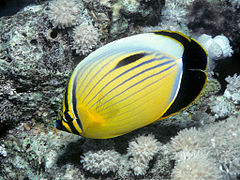Blacktail butterflyfish
| Black-tailed Butterflyfish | |
|---|---|

| |
| Scientific classification | |
| Kingdom: | |
| Phylum: | |
| Class: | |
| Order: | |
| Family: | |
| Genus: | Chaetodon (but see text)
|
| Subgenus: | Corallochaetodon
|
| Species: | C. (C.) austriacus
|
| Binomial name | |
| Chaetodon (Corallochaetodon) austriacus Rüppell 1836
| |
| Synonyms | |
|
Chaetodon klunzingeri Kossmann & Räuber, 1877 | |
The Black-tailed Butterflyfish (Chaetodon austriacus), also known as blacktail butterflyfish or exquisite butterflyfish, is a species of butterflyfish native to the Middle East.
Distribution
The species is native to the Red Sea and southern Oman.[2] As of 2011 it has been present on the Mediterranean coast of Israel, evidently as a Lessepsian migrant via the Suez Canal.[3]
Taxonomy
Together with the Melon and Oval butterflyfishes and probably also the somewhat aberrant Arabian butterflyfish (C. melapterus), the blacktail butterflyfish makes up the subgenus Corallochaetodon. They are probably quite close to the subgenus called Citharoedus (that name is a junior homonym of a mollusc genus), which contains for example the Scrawled butterflyfish (C. meyeri). Like that group, they might be separated in Megaprotodon if the genus Chaetodon is split up.[4][5]
Description
The Black-tailed Butterflyfish is up to 14 cm long and is orange with thin, curved black stripes. Its anal fin and tail are black. The body of juveniles is whiter above with white bands on the tail. The Melon butterflyfish (C. trifasciatus) and the Oval butterflyfish (C. lunulatus) are similar in coloration but have less black on the caudal and anal fins.[6]
Ecology
Black-tailed butterflyfishes tend to be found in coral-rich areas between 0.5 and 20 m deep, on seaward reefs or in lagoons or bays. Adults are generally found in pairs patrolling a territory or range while juveniles are found among coral branches. This species grazes on coral polyps and sea anemone tentacles.[6]
Footnotes
- ^ Rocha, L.A.; Craig, M.T.; Pratchett, M. (2010). "Chaetodon austriacus". IUCN Red List of Threatened Species. 2010. IUCN: e.T165634A6074982. Retrieved 22 February 2016.
{{cite journal}}: Unknown parameter|last-author-amp=ignored (|name-list-style=suggested) (help) - ^ Froese, Rainer; Pauly, Daniel (eds.). "Chaetodon austriacus". FishBase. February 2016 version.
- ^ Menachem Goran; Roy Gvili; Bella Galil (2011). "The reef-associating butterfly fish Chaetodon austriacus Rüppell, 1836 in the Mediterranean: The implication of behavioral plasticity for bioinvasion hazard assessment". Aquatic Invasions. 6 (supplement 1): s143–s145. doi:10.3391/ai.2011.6.S1.032.
{{cite journal}}: Unknown parameter|last-author-amp=ignored (|name-list-style=suggested) (help) - ^ Fessler, Jennifer L.; Westneat, Mark W. (2007). "Molecular phylogenetics of the butterflyfishes (Chaetodontidae): Taxonomy and biogeography of a global coral reef fish family". Molecular Phylogenetics and Evolution]]. 45 (1): 50–68. doi:10.1016/j.ympev.2007.05.018.
- ^ Hsu, Kui-Ching; Chen, Jeng-Ping; Shao, Kwang-Tsao (2007). "Molecular phylogeny of Chaetodon (Teleostei: Chaetodontidae) in the Indo-West Pacific: evolution in geminate species pairs and species groups" (PDF). Raffles Bulletin of Zoology Supplement. 14: 77–86.
- ^ a b Lieske, E.; Myers, R.F. (2004). Coral reef guide - Red Sea. London: HarperCollins. ISBN 0-00-715986-2.

